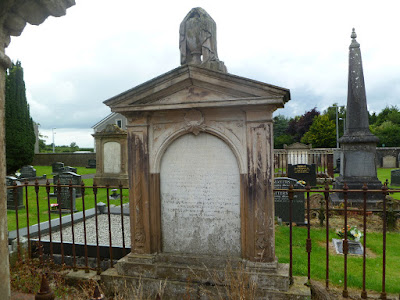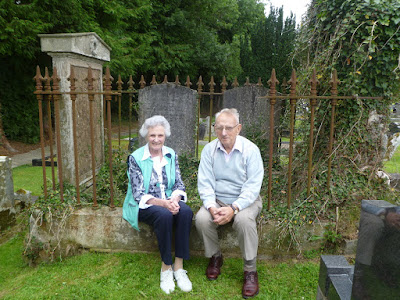After having visited Banagher in 2013 (where Arthur Bell Nicholls grew up and spent the last years of his life) and the Northern Irish homeland in 2014 (Rev. Patrick Brontë’s roots), we were once more on the Brontë trail, this time in the Connemara.
Ever since I read the books on the life of Arthur Bell Nicholls two years ago, I have become fascinated by this man who played such a significant role in Charlotte Brontë’s life. Over the years, without even realizing it, my husband and I visited the places in Ireland related to the Brontës, in particular the places Charlotte and Arthur visited on their honeymoon.
When reading the story about Arthur Bell Nicholls’ life I discovered where he came from and where he spent his life after returning to Ireland. I came across a few other places that needed further investigation. One of them was Kill House near Clifden in the Connemara. This is the house where Arthur’s cousin, Harriette Bell lived with her husband and six of their seven children. Harriette was
the cousin Arthur proposed to in 1851 and who declined his proposal.
My husband and I became intrigued with this house. We had been looking at the internet and found a vague location near the Sky road (Clifden). We knew the area quite well and have been driving around on the Sky road peninsula many times, but we could not figure out where the house would be situated.
This year, armed with a google map (very vague) and an old picture of the house, we went back to the Sky Road peninsula to have a better look. We were driving very slowly so as to have a good look at all the “big” houses we passed . We took all possible byways and turned corners on very narrow roads. Driving a van on those narrow Irish roads is not an easy thing to do, believe me!
Finally, I thought I saw a house in the far distance that looked like a house similar to the one in the picture. We took the byway, which led us to a peninsula off the Sky road peninsula, and arrived in a “village” (which we later found out to be Cill). We recognized the place, we had been there many years ago to try and find a B&B with angling facilities, where some Belgian anglers had been staying.
The house that I had seen in the distance was near that B&B, up the hill. Great was my joy when we arrived and it matched exactly the picture that I had in my hand. The sign next to the gate confirmed this. We had found “Kille House”! I was over the moon.
The house is now in private hands and cannot be visited. But just standing there at the gate and looking at the house was enough for me! Another personal mission accomplished!
Two weeks later we were back in Northern Ireland, Co. Down, to meet up with Margaret Livingston and Finny O’Sullivan from the Northern Irish Branch of the Brontë Society. Last year Margaret and Finny took us on the homeland trail to trace Rev. Patrick Brontë's roots. Finny mentioned some other places that we might visit this year, off the beaten track again, and certainly not on the homeland tour. So, off we went again, on a Brontë tour with a difference!
The first stop was Tully farm in Killead (Co. Antrim), the house where Arthur Bell Nicholls was born. It is a two-storey farmhouse looking out across the fields to Lough Neagh and the Sperrin mountains. The house has changed since the days that Arthur lived here with his parents, William and Margaret Nicholls (née Bell), and his brothers and sisters. Arthur lived here up to the age of 7 when he and his brother Alan moved to Cuba House in Banagher to live with their uncle Dr. Alan Bell and his family. Dr. Alan Bell raised the two boys as his own, offered them a good education and ensured a good start in life for them, which they would not have had if they had stayed in Killead.
The next stop on our tour was Killead Church and graveyard on Drennans Road, where we visited the grave of Arthur Bell Nicholls’ parents and some of his siblings. It is said that Arthur and his brother never went back to their birthplace and never saw their parents again, although the families did keep in touch. Margaret Nicholls née Bell was born in the nearby village of Glenavy, and that was where we were heading to next: Glenavy Church and graveyard. The Bell graves are not easy to find, you really must know where to look, but luckily for us, Finny did know. The graves are very overgrown and it is very difficult to decipher the names , but we could discover a few names of the Bell family on the gravestones.
Marina Saegerman
19 September 2015
For further reading, the following books can be recommended:
“My dear boy - the life of Arthur Bell Nicholls “(Margaret and Robert Cochrane)
“Mr Charlotte Brontë – the life of Arthur Bell Nicholls” (Alan H. Adamson)






2 comments:
Dear Marina
My husband and I are just back from Banagher. In fact it was your 2013 Brussels Bronte Blog post that alerted me to the fact his home, Hill House, was now a B and B and that inspired our trip!
Now I find you have inspired us yet again with your further adventures! What a marvelous trip and post! How grand to have a guide like Finny!
It's been a mystery to me for years why Arthur has been often ignored. Not just anyone could get a Bronte to the alter and make them happy! I've been a fan of his for many years
You may enjoy seeing my recent painting of Mr. Nicholls in mid-life
http://annie-stayathomeartist.blogspot.com/2015/08/rev-arthur-bell-nicholls_31.html
and my post about our trip to Banagher
http://annie-stayathomeartist.blogspot.com/2015/10/banagher.html
Thank you so much!
Anne Lloyd
Sounds like a great trip! I've wanted to go to Banagher for many years. It looks lovely.
Post a Comment